SOL was the first Finnish company to move into an activity-based office during the economic slump of the 1990s
It was year 1992. Finland was suffering from a severe economic downturn. Recently founded SOL Group believed in flat organization and created completely new kind of a working environment to support it. People were free to choose their work stations. They kept their personal items in red bags. The use of paper was minimized. No secretaries were hired, and the CEO sometimes answered calls at the switchboard. SOL was years ahead of its time.
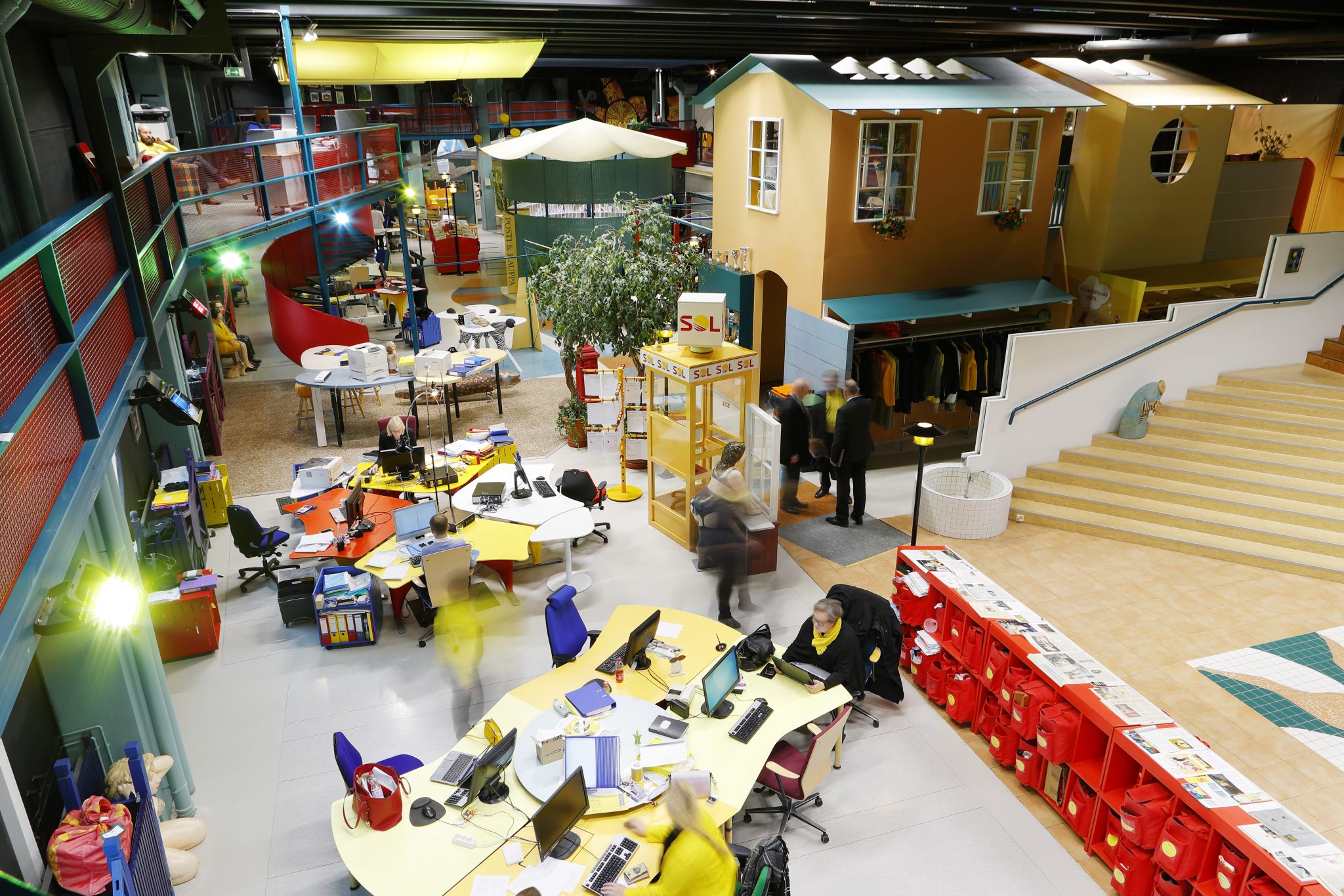
Step into our solar system, it says on their yellow door.
We’re entering SOL City, in other words the head office of the SOL Group on Vanha Talvitie in the Sörnäinen district of Helsinki.
Having opened the door, we see a huge open space full of colors, details and surprises. Eyes start to wonder. The milieu invites us to step further. On the way from the reception to the wardrobe, we see a yellow phone booth, a forum with a fountain, a genuine English mailbox and several naive sculptures monitoring the life in SOL City. Bright yellow and red tones captivate our minds.
One cannot but smile at the view.
“This is exactly what we’re after. Smiles, good spirits, joy and positivity. That’s what SOL’s all about,” says Chairwoman of the Board at SOL Palvelut Oy, Anu Eronen.
The name of the company, Sol, is the Latin word for the sun. This huge star is present in the company logo, visual identity, workwear and everywhere in the premises. The brand colors, red and yellow, also refer to the sun.
Sunshine is embedded in people’s attitudes, too. The sun shines through the hardest of days.
Finland was going through a depression when the SOL group was founded in 1992. Finnish companies were struggling. They were saving on everything possible. Including the cleaning.
In order to succeed, a start-up company needed to have courage and introduce alternative ways of working. Led by Liisa Joronen, SOL decided to increase the value of cleaning work. The company believed in equality and co-creation. They decided to invest in a unique brand right from the start. The name was chosen based on the personnel’s proposals, and the sunny image created around it helped the company to stand out among the competition.
A completely new kind of working environment
An old photography studio was found to function as the head office of the new company. The walls were black, but the high ceilings had potential. Jari Inkinen and Hanna Gullstén were invited to design the premises.
“When we went to see the studio, it was a bit daunting to realize that we only had a few windows and completely black walls to cope with. Now, afterwards, I can say we did well,” Jari Inkinen reflects.
The baseline for the spatial design was a new way of looking at a work place. Why must an office look like an office?
“Why must we have rooms, walls or even dividers between people? Why must we use office furniture? We wanted to create something between work and home. A place with a homey atmosphere that welcomes people and provides enjoyment,” Anu Eronen says.
“The premises also needed to support the flat organization. We wanted everyone to be able to talk with everyone. In an open space, there should be many large tables around which to gather.”
All of the personnel were engaged in the design.
“We came together to brainstorm an optimal working environment and what could be included. Everybody’s proposals were written on a flip chart. Somebody suggested a fountain, so that’s what we had,” Eronen says.
Personal items from cabinets to bags
For Gullstén-Inkinen, the SOL project was like winning the lottery.
“We were able to develop a completely new type of working environment,” Jari Inkinen says. “Flexible concepts are common these days, but in 1992, this approach was unheard of.
“First of all we investigated the physical need for space in different tasks. Today, we speak of recognizing work profiles within the development of a work environment. Each profile needs a specific environment. In that time, we used traditional need-based surveys to ask how much storage people needed.”
Based on the result of the survey, no space was left for people in SOL’s premises, only storage.
This sparked the idea of the new concept. People could keep their items in bags.
“With Anu and Liisa, we questioned how much stuff people really need. We checked what materials were kept in the cabinets and laid them on the table according to different tasks. Each profile gained a pile of material, a few folders in practice. We realized it was not necessary to keep them in a cabinet. I had a Marimekko bag that I’d carried around since high school. We came up with the idea to put the material in a bag like that!” Jari Inkinen recalls.
Jari designed a new version of the bag with pockets and other necessary details. Marimekko was asked to manufacture the bags for SOL. They did indeed do so, and since the 1990s, each SOL employee receives a red Marimekko bag to store their work items.
This invention meant that nobody – not even the executives – needed to have their own dedicated desk. At the end of the day, everybody would fill their bags and bring them to the bag station, leaving the desk empty and available for someone else to occupy.
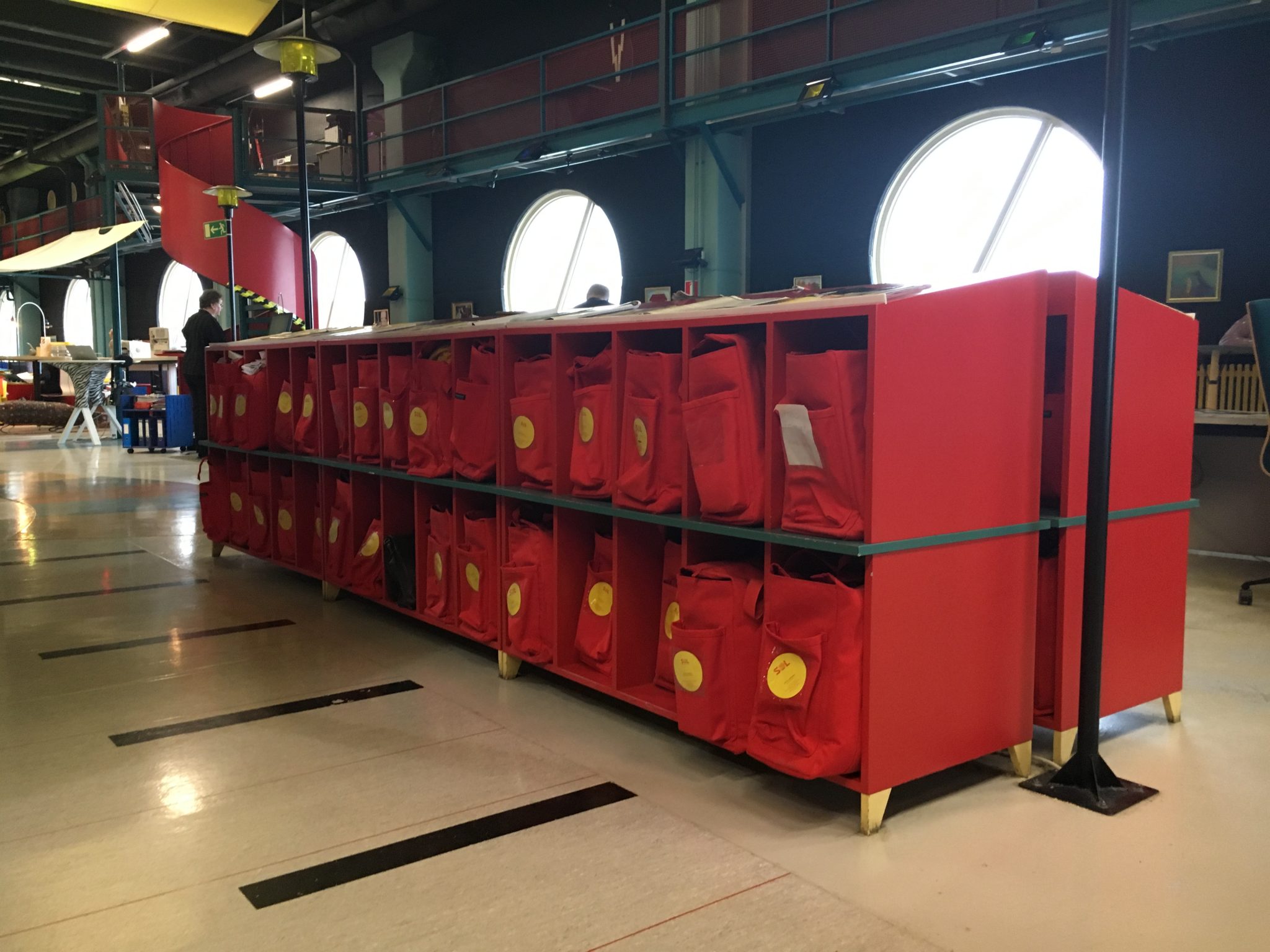
This unique spatial concept also supported SOL’s pioneering role regarding the paperless office. The company seeked to abolish unnecessary paperwork already in the 1990s.
What sparked the idea of calling the place SOL City?
“We thought that a tight working community is like a village or a small city. It includes separate spaces for various functions like working, eating and meeting people. We imagined a city with streets, banks and post offices. When the property was expanded in 1995, we designed a central square and wide Spanish stairs. In the middle of the square, we created a solid sun-themed tiled area to support the brand,” Jari Inkinen explains.
Since then, the central square has functioned as a meeting area for the various events organized by the company.
“These days, nearly every public building and office wants to offer the same kind of staircase experience as we designed then,” Inkinen notes.
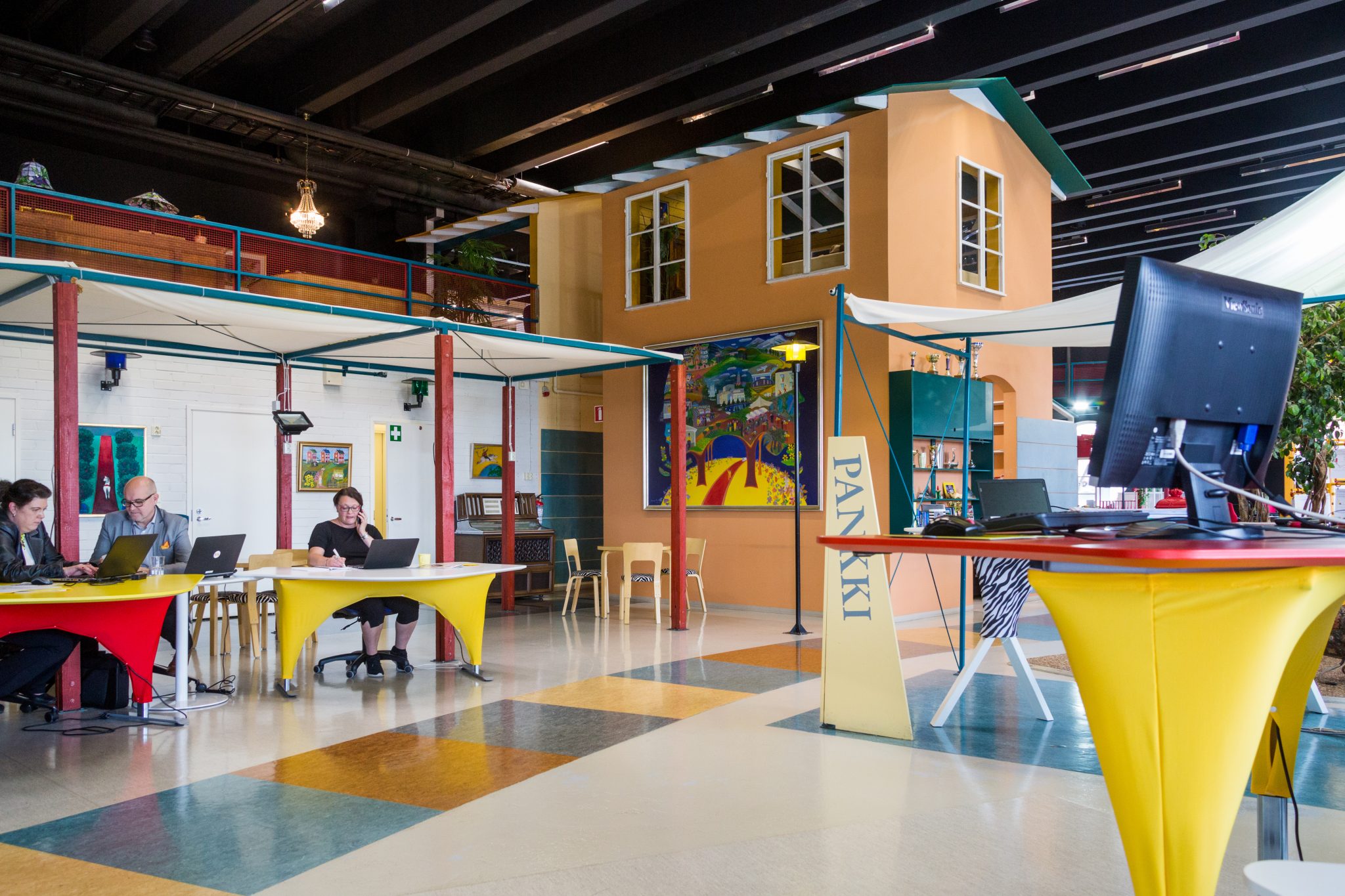
The concept remains
Anu Eronen appreciates the SOL City concept. “I wouldn’t trade it for anything,” she says. “Thanks to Jari and Hanna’s functional and colorful ideas, we managed to create a unique working environment that still serves our company culture today.”
According to office user survey by Taloustutkimus Oy in 2016, the SOL premises match the company values and function well.
“Last year, the company Into Concept founded by Hanna and Jari delivered new and innovative desks and chairs for us in order to improve ergonomics. Otherwise the spatial concept is the same.”
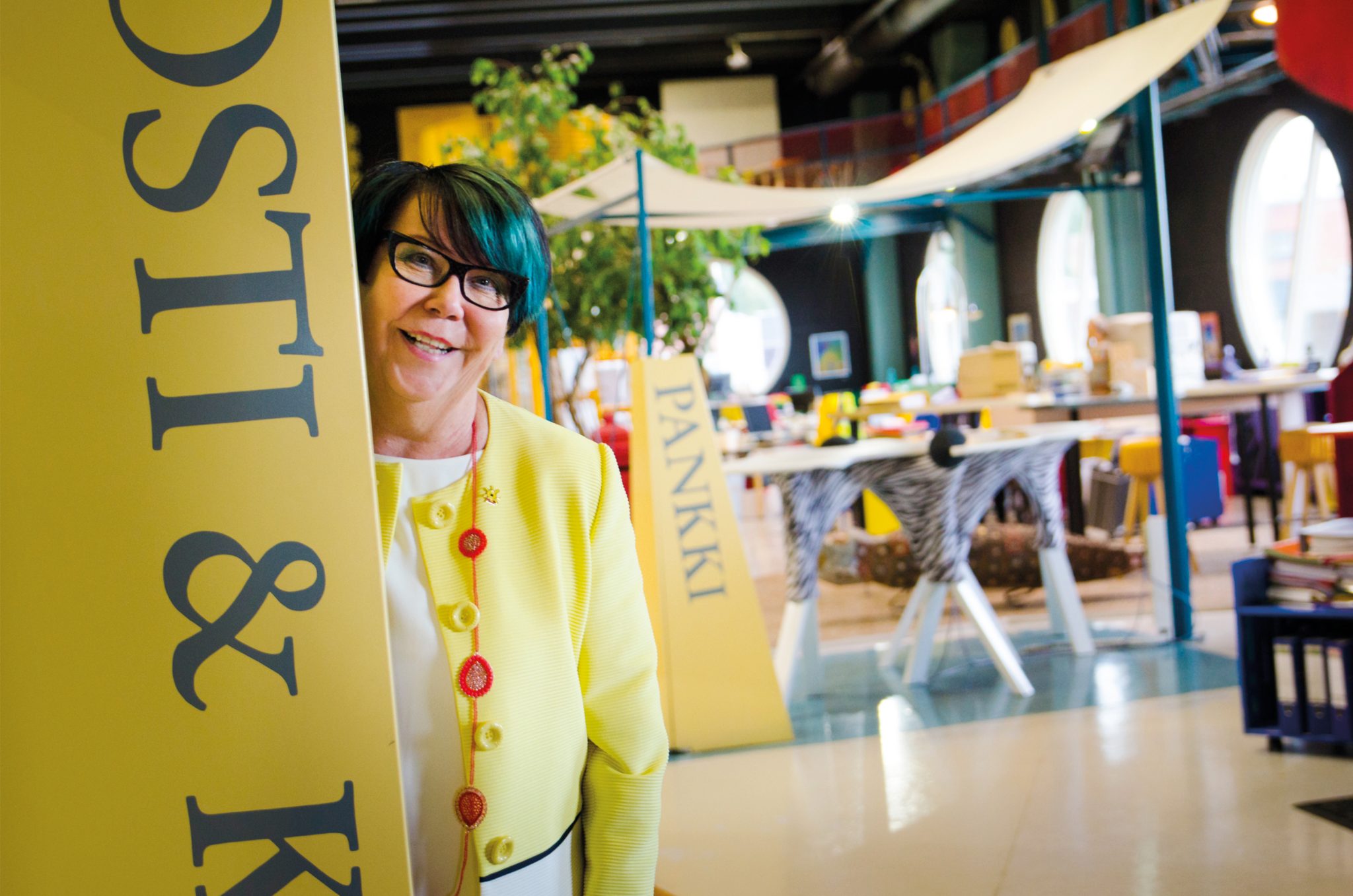
“We wanted adjustable tables to alternate between sitting and standing positions. However, the cabling was too visible around the tall tables. Jari met this challenge with a colorful “trouser desk” idea. It’s yet another example of solving problems in an fun way,” says Anu Eronen.
Stories and art
A tour in SOL City is like an inspiring walk around town. Each object involves a story. Many of them also carry personal importance, as employees have brought them to work from their homes or summer cottages. This creates an element of surprise. There’s a jukebox next to some Artek chairs. A genuine crystal chandelier is hanging from the black ceiling upstairs.
SOL City also houses one of the largest collections of naive art in Finland.
“Naive art is life-like, fun and humane. It supports our values and matches our premises perfectly,” Eronen says.
Art has been part of the SOL Group’s identity since the very beginning. The artworks come from many different artists.
In the kitchen, Jan-Erik Andersson’s “Crispbread Table” and “Peanut Benches” have been in daily use for more than twenty years. Jakke Haapanen’s surreal door paintings represent the latest purchases. On the back wall is a mosaic sun created by nine artists for a Fiskars art event. The graffiti by the entrance is a good example of how a restless wall with fire doors and file cabinets can be masked as part of artwork.
Believing in one’s own vision
What is Anu Eronen’s favorite place in SOL City?
“I like the open space because there I’m constantly aware of what’s going on. When I was the CEO, I used to sit at the switchboard and take calls. That was a great way of learning what’s going on. Another of my favorite places is the bridge that leads to the Playhouse upstairs. Looking at the space from above provides a different angle and helps proceed in a new manner.”
Eronen has always believed in her own vision and encourages others to do the same. She follows two guidelines: Do things boldly and differently. A basic concept is not good enough. Secondly, do things together with the personnel.
SOL’s operating environment built in the 1990s is a fabulous example of having the courage to do things differently.
“Nowadays this kind of a space is called an activity-based office,” Jari Inkinen says. “And nowadays half of the world wants to work in this kind of environment. In Finland and in the Nordic countries, many already do. But it’s likely that SOL has been operating in an activity-based office longer than any other company in the world.”
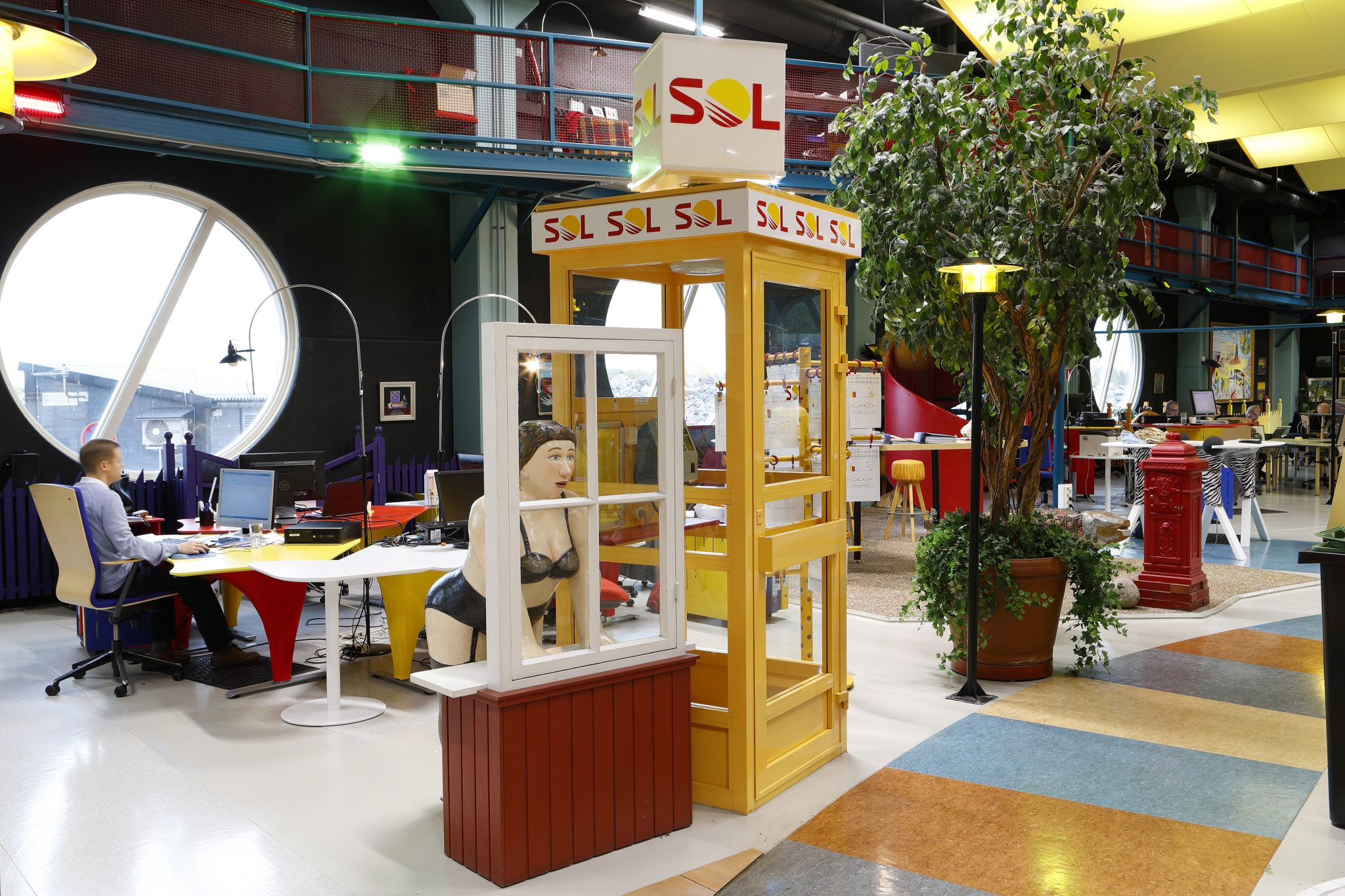
Text: Minna Helkiö
Photos: Gullstén-Inkinen and SOL
Gullstén-Inkinen Design & Architecture is the largest design agency in the Nordic countries specializing in architectural and interior design and real estate renovation. Our award-winning agency provides individualized, cost-efficient and sustainable design solutions for offices, hotels, restaurants, public spaces and real estate renovation projects.
We also offer top-quality workplace development services for businesses and organizations looking to foster a better work culture, improve internal communications or boost overall employee productivity.

